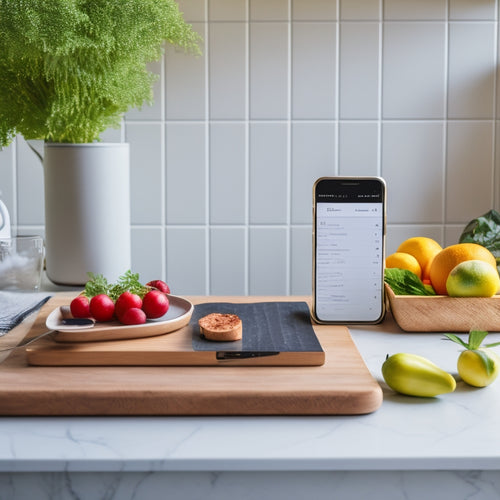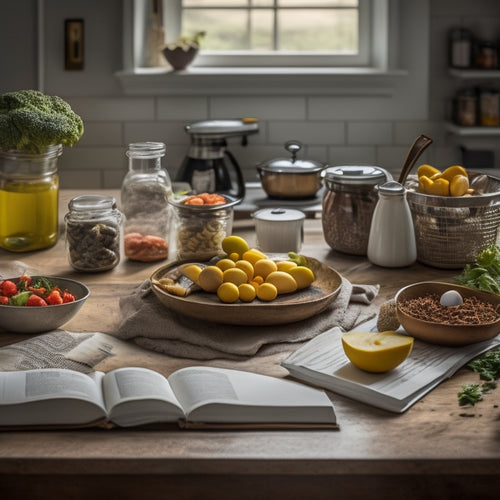
Why DIY Kitchen Organization Fails Without a Plan
Share
You've decided to tackle a DIY kitchen organization project, but without a solid plan, you're setting yourself up for failure. You might start with enthusiasm, but soon find yourself overwhelmed by clutter, wasted money, and frustration. The problem often lies in the lack of clear goals, inaccurate space measurements, unrealistic time expectations, poor product choices, and incomplete task prioritization. To avoid these common pitfalls, take a step back and assess your needs, space, and time constraints. By doing so, you'll be able to create a tailored plan that addresses your unique pain points, and you'll be on your way to a functional, clutter-free kitchen that meets your needs.
Key Takeaways
• Without clear goals, DIY kitchen organization projects often fail to address specific pain points and can lead to a cluttered space.
• Inaccurate space measurements can result in wasted money, materials, and inefficient use of kitchen space.
• Unrealistic time expectations can lead to frustration, while effective time management and task prioritization are crucial for project success.
• Selecting the wrong products can hinder workflow and functionality, emphasizing the importance of researching and choosing products that align with organizational systems and goals.
• Failing to prioritize tasks can lead to a chaotic experience, making it essential to categorize tasks by importance and urgency and focus on high-priority tasks first.
Lack of Clear Goals Defined
When you start a kitchen organization project without defining clear objectives, you're more likely to end up with a cluttered space that still doesn't meet your needs. Without a clear direction, you'll waste time and resources on solutions that don't address your specific pain points. This is a common planning pitfall that can lead to frustration and disappointment.
To avoid this, take the time to set specific, measurable, and achievable goals for your kitchen organization project.
What do you want to achieve? Do you want more counter space, better storage for utensils, or a more efficient workflow? Write down your goals and prioritize them.
This will help you stay focused and guarantee that your efforts are directed towards creating a space that meets your needs.
Inadequate Space Measurement Errors
Measure your kitchen space incorrectly, and you'll end up with a design that's doomed from the start, wasting money and materials on solutions that won't fit or function as planned. You'll be left with a kitchen that's still cluttered and disorganized, despite your best efforts.
One common mistake is incorrect shelf heights. If you don't take into account the size and shape of your kitchen items, you'll end up with shelves that are too high or too low, making it difficult to access what you need.
Another mistake is overestimating cabinet space. Don't assume you can fit more items in your cabinets than they can actually hold. Take precise measurements of your kitchen space, including the dimensions of your cabinets, countertops, and appliances. Make note of any obstacles, such as plumbing or electrical outlets.
With accurate measurements, you'll be able to design a kitchen organization system that works for you, not against you. Take the time to get it right, and you'll be on your way to a kitchen that's functional, efficient, and clutter-free.
Unrealistic Expectations of Time
You've got your kitchen space measured accurately, but now it's time to face another common DIY pitfall: underestimating the time it takes to complete your organization project. This mistake can lead to frustration, burnout, and an unfinished project. Don't fall into the trap of thinking you can whip up a perfectly organized kitchen in a weekend. Effective time management is vital to success.
Take a step back and evaluate your project scope. Break down the tasks into smaller, manageable chunks, and allocate realistic time frames for each one. Consider your availability, skill level, and the complexity of each task.
Be honest with yourself - can you really dedicate 10 hours this weekend to building custom shelves? Probably not. By overestimating your capabilities, you'll set yourself up for disappointment. Instead, create a schedule that allows for flexibility and contingency planning.
Improper Product Selection Mistakes
Selecting the wrong products for your DIY kitchen organization project can lead to a host of problems, from wasted money and time to a finished result that fails to meet your needs. You might end up with a cluttered kitchen, inefficient workflow, and a sense of frustration. To avoid this, you need to choose products that align with your organizational systems and goals.
When it comes to product placement, consider the 'golden triangle' concept, where your most frequently used items are placed within easy reach. This will streamline your workflow and reduce clutter. However, if you choose products that don't fit your kitchen's layout or your cooking style, you'll end up with a dysfunctional space.
Take the time to research and select products that cater to your specific needs. Measure your kitchen space, identify your pain points, and choose products that address those issues.
Don't be swayed by trendy designs or cheap prices; instead, focus on functionality and quality. By doing so, you'll create a kitchen organization system that truly works for you, not against you.
Incomplete Task Prioritization Lists
Failing to prioritize tasks in your DIY kitchen organization project can lead to a chaotic and overwhelming experience, causing you to waste time and energy on non-essential tasks. Without a clear plan, you'll likely find yourself jumping from one task to another, never really making progress. This is because you haven't identified the most critical tasks that need to be completed.
You need to prioritize your tasks to make certain task completion. Start by making a list of all the tasks you need to accomplish, then categorize them based on importance and urgency. Focus on the high-priority tasks first, and break them down into smaller, manageable chunks. This will help you stay focused and motivated, ensuring you're making progress towards your goal.
Effective priority management is key to completing your DIY kitchen organization project efficiently. By prioritizing your tasks, you'll be able to allocate your time and resources effectively, guaranteeing you're getting the most out of your effort.
Ignoring Personal Workflow Habits
As you work on prioritizing tasks, it's equally important to acknowledge your personal workflow habits, which can either support or hinder your DIY kitchen organization project's progress. You see, your behavior patterns and daily routines can greatly impact the success of your project.
For instance, if you're a morning person, you might want to schedule your most critical tasks for then. On the other hand, if you're prone to procrastination, you'll want to break down larger tasks into smaller, manageable chunks.
To achieve workflow customization, take some time to reflect on your strengths and weaknesses. Identify the times of day when you're most focused and energized, and allocate tasks accordingly. By doing so, you'll be able to create a tailored workflow that caters to your unique needs and preferences.
Inefficient Storage Allocation Plans
You've likely encountered inefficient storage allocation plans in your kitchen, where cluttered countertops and cramped cabinets hinder your ability to cook and prepare meals efficiently. This is often due to a lack of strategic planning, resulting in wasted space and disorganization.
Without a clear plan, you may end up with shelving solutions that don't meet your needs or drawer dividers that fail to keep utensils and supplies organized.
To avoid this, it's crucial to assess your kitchen's unique needs and identify areas for improvement. Consider the items you use most frequently and allocate storage space accordingly.
For example, if you have a large collection of cookbooks, invest in a dedicated shelving solution that keeps them easily accessible. Similarly, use drawer dividers to separate utensils, spices, and other essentials, making them easy to find when you need them.
Frequently Asked Questions
What Are Some Common DIY Kitchen Organization Mistakes Beginners Make?
When organizing your kitchen, you often overlook important steps, like not labeling essentials or investing in insufficient storage solutions, which can lead to clutter and disarray, wasting your time and energy.
Can I Repurpose Old Furniture for Kitchen Organization Projects?
"Like a master chef, you're whipping up creative solutions! You can repurpose old furniture for kitchen organization projects, turning vintage dressers into island storage or upcycling crates into shelves. Get crafty and breathe new life into old pieces!"
How Do I Declutter My Kitchen Before Organizing It?
You'll tackle kitchen decluttering by purging expired food, sorting items into categories, and assigning homes using pantry organization systems and drawer dividers, creating a sense of control and clarity before organizing.
Are Modular Kitchen Organization Systems Worth the Investment?
You're wondering if modular kitchen organization systems are worth the investment. Investigating the theory, it's clear that balancing budget vs. quality and weighing custom vs. pre-made options is essential to achieving a tailored, high-functioning space that justifies the cost.
Can I Organize My Kitchen on a Very Limited Budget?
You can organize your kitchen on a very limited budget by getting creative with budget-friendly solutions and repurposing items you already own, and implementing clever storage ideas that maximize space without breaking the bank.
Related Posts
-
Versatile Stainless Steel Alligator Chip Bag Clip For Fresh Food Storage
In a world filled with technological advancements and complex gadgets, it is refreshing to find simplicity in everyda...
-

Simplify Meal Planning With These 5 Essential Apps
You're tired of last-minute takeout and wasted groceries, and you're not alone. Simplify meal planning with these 5 e...
-

Why Keto Dieters Need a Meal Planning System
You need a meal planning system to supercharge your keto diet because without one, you'll be stuck in a vicious cycle...

